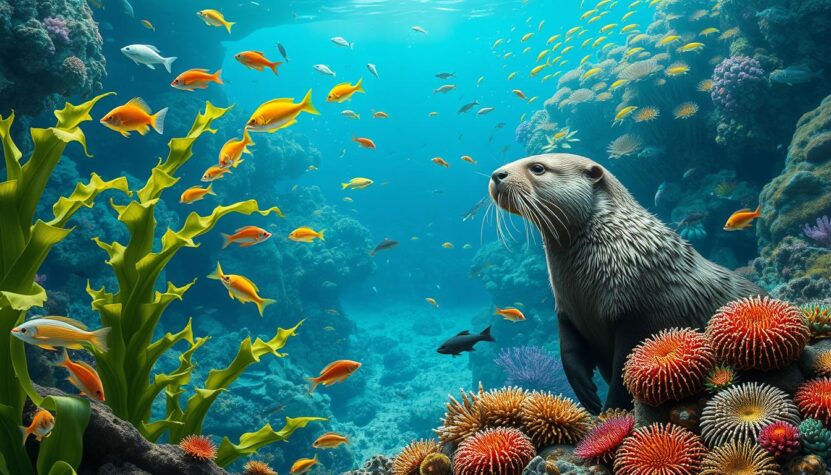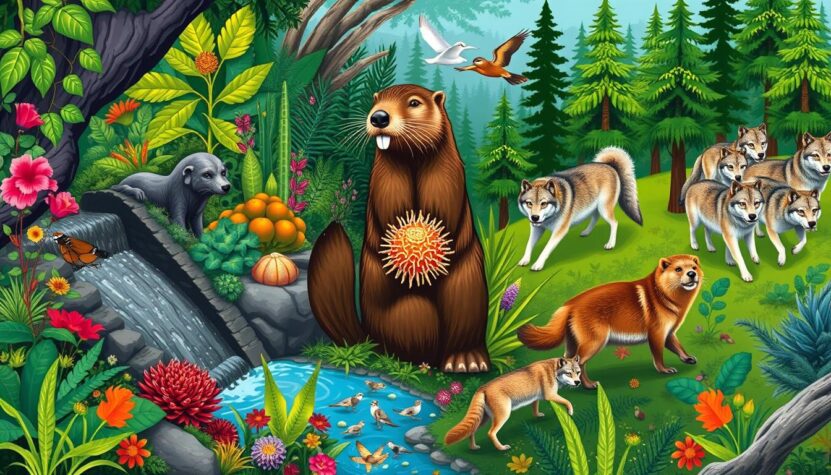In the realm of ecology, certain species emerge as pivotal players in sustaining the intricate web of life. Known as keystone species, these organisms exert a disproportionately large influence on their environment compared to their population size. Understanding the keystone species importance is critical because their presence, or absence, can dramatically alter ecosystem dynamics, impacting biodiversity and leading to instability within various habitats. When these essential species are lost, the delicate balance of nature is disrupted, often resulting in significant ecological repercussions. This highlights the urgency of recognizing and protecting keystone species to ensure the longevity of diverse ecosystems.
Understanding Keystone Species
A keystone species plays a crucial role in maintaining the structure and health of its ecosystem. Understanding the keystone species definition involves recognizing that these organisms, whether they be predators, prey, or plants, significantly influence the surrounding biodiversity. Their unique characteristics contribute to the overall stability of their ecological communities.
Definition and Characteristics of Keystone Species
The keystone species definition focuses on organisms that have a disproportionately large impact on their environment relative to their abundance. Some key characteristics of keystone species include:
- Regulatory Role: They help manage populations of other species, preventing overpopulation and the monopolization of resources.
- Food Web Connectivity: Their interactions serve as critical links in the food web, affecting many other species.
- Habitat Modification: Some species create or alter habitats, providing essential resources for various organisms.
- Maintenance of Diversity: They promote a diverse community by supporting a range of species.
Importance of Keystone Species in Ecosystems
The importance of keystone species in ecosystems cannot be overstated. These organisms maintain the dynamic balance within their habitats. Their role ensures:
- Prevention of Overgrazing: By controlling herbivore populations, they protect plant diversity and health.
- Stabilization of Community Structure: Their presence fosters equilibrium, allowing predator and prey relationships to flourish.
- Enhancement of Ecosystem Services: Keystone species facilitate processes such as pollination, nutrient cycling, and habitat creation.
The absence of keystone species often leads to a cascade of ecological changes, highlighting their vital contributions. Recognizing these organisms and their roles fosters a deeper appreciation for biodiversity and ecological balance.
The Role of Keystone Species in Ecosystems
Understanding the intricate relationships within ecosystems reveals how keystone species shape their environments. Key players include both predators and herbivores, whose interactions create balance and promote biodiversity.
Predators and Their Impact
Predators as keystone species play a pivotal role in maintaining ecosystem stability. They help control herbivore populations, preventing overgrazing and ensuring a healthy plant community. This dynamic exemplifies the role of predators in ecosystems, facilitating a balance that supports various plant and animal life. By managing the distribution and behavior of herbivores, predators contribute to a cascading effect that fosters plant diversity, enhancing habitats for many species.
Herbivores and Plant Dynamics
Herbivores as keystone species significantly influence their environments. Their grazing activities can shape vegetation, promoting a mosaic of plant communities. This process has direct effects on plant dynamics, facilitating growth in some species while restricting others. Notably, large herbivores like elephants can maintain open landscapes, which in turn creates habitats for a variety of organisms. The effects of herbivores on plant dynamics illustrate the interconnectedness of species, emphasizing how changes within one group can reverberate throughout the entire ecosystem.
Why Keystone Species Are Crucial for Biodiversity and Ecosystem Stability
Keystone species play an essential role in maintaining biodiversity and the stability of ecosystems. Their influence extends beyond their population size, directly impacting various ecological relationships and contributing to the resilience of natural environments. By protecting keystone species, you support the entire ecological network, ensuring healthy ecosystems.
Maintaining Species Diversity
Keystone species are vital for maintaining biodiversity. They help regulate population sizes of other species within their habitats, which fosters a richer diversity of flora and fauna. This interaction creates varied ecosystems that allow different organisms to thrive, while also improving the overall health and functionality of these environments. Rich biodiversity aids ecosystems in adapting to changes and challenges, including diseases and natural disasters.
Stabilizing Ecological Relationships
The presence and activities of keystone species stabilize ecological relationships by promoting balance among different species. Their interactions encourage cooperation and competition in ways that sustain ecosystem health. This stability is crucial for critical ecosystem services, including nutrient cycling, pollination, and carbon storage. Without these key players, the intricate web of life becomes vulnerable, risking the decline of biodiversity and the functions that support human life.
| Keystone Species | Impact on Biodiversity | Impact on Ecosystem Stability |
|---|---|---|
| Wolves | Control deer populations, promoting diverse plant growth | Maintain healthy herbivore populations that support various plant species |
| Beavers | Create wetlands that nurture diverse aquatic life | Stabilize water levels, supporting various ecosystems |
| Corals | Provide habitat for numerous marine species | Support the overall health of marine ecosystems through structural complexity |
How Keystone Species Affect Ecosystems
Understanding how keystone species affect ecosystems involves examining the critical roles they play within food web dynamics and habitat influence. These species serve as integral links in food chains, connecting various species and helping to stabilize ecological relationships. The removal of any keystone species can result in significant ecological imbalances, impacting both predators and prey throughout the network. This section delves into the essence of food web interconnections.
Food Web Interconnections
Keystone species are crucial within food web dynamics. For example, top predators such as wolves regulate herbivore populations, preventing overgrazing and allowing plant communities to thrive. Similarly, various herbivores can significantly affect vegetation and, consequently, the animal species that rely on it. Here are some key points to consider:
- Top predators maintain balance among herbivores.
- Herbivores influence plant diversity and abundance.
- Plant communities provide shelter and food for numerous organisms.
Influence on Habitats
Keystone species also demonstrate the habitat influence of keystone species and habitat creation. For instance, beavers act as ecosystem engineers by constructing dams that create wetlands. These wetlands support a wide range of flora and fauna, enhancing biodiversity. The following table illustrates different keystone species and their habitat creation effects:
| Keystone Species | Habitat Type | Impact on Ecosystem |
|---|---|---|
| Beavers | Wetlands | Increased biodiversity through water retention and habitat for various species. |
| Elephants | Savannah | Uprooting trees creates grasslands, promoting diverse plant and animal life. |
| Sea Otters | Kelp Forests | Control sea urchin populations, allowing kelp forests to thrive and supporting marine biodiversity. |
Through these examples, the critical role of keystone species in shaping their environments becomes evident. Understanding how keystone species affect ecosystems not only highlights their importance but also emphasizes the myriad interconnections that sustain ecological health.
Examples of Keystone Species
Understanding the significance of keystone species can enhance your appreciation of ecosystems. Let’s explore some prominent examples of keystone species that illustrate their critical roles in maintaining biodiversity and ecological balance.
Top Predators: Wolves and Their Role
Wolves as a keystone species demonstrate their importance through their predatory behavior. In Yellowstone National Park, their presence has helped maintain the population of herbivores, such as elk. This management prevents overgrazing, allowing vegetation to thrive. Healthy plant life creates habitats that support various other species, showcasing how wolves contribute to the stability of ecosystems.
Coral Reefs as Keystone Ecosystems
Coral reefs serve as remarkable examples of keystone ecosystems. These vibrant underwater structures provide a habitat for countless marine species and contribute significantly to coastal protection. The health of coral reefs directly influences marine biodiversity, affecting fish populations, sea turtles, and many other organisms. Maintaining these ecosystems is vital not just for the marine life they harbor but also for human communities reliant on their resources.
Beavers: Engineers of Ecosystem Stability
Beavers and ecosystem engineering play a crucial role in shaping their environments. Their dam-building activities result in the creation of wetlands, which are vital for numerous animal species. These wetlands improve water quality and regulate stream flows, expanding habitats for various aquatic and terrestrial species. Beavers exemplify keystone species examples by enhancing biodiversity and promoting ecological health through their natural engineering efforts.
Keystone Species and Biodiversity
Understanding the role of keystone species is essential for grasping their direct effects on species population dynamics. These organisms play a crucial part in maintaining balance within their ecosystems. Their presence can stabilize population sizes among various species, from predators to prey. For instance, when wolves are present in an ecosystem, their hunting regulates deer populations, which in turn allows vegetation to thrive. This balance protects biodiversity and promotes a healthier environment.
Direct Effects on Species Population
The direct effects of keystone species extend far beyond the immediate interactions within populations. The removal of a keystone species can lead to dramatic shifts in species population dynamics. In situations where a predator or herbivore is removed, the affected species may experience population booms, potentially leading to overgrazing or depletion of resources. This can have a cascading effect, disrupting entire ecosystems and threatening biodiversity.
Indirect Effects on Ecosystem Functions
Keystone species also have significant indirect effects on ecosystem functions. These organisms influence nutrient cycling and energy flow, contributing to the overall health of the ecosystem. For instance, beavers shape their environment by building dams, which can create wetland habitats. These wetlands enhance biodiversity by providing critical resources and habitat for various organisms. By mediating interactions among species, keystone species play a vital role in sustaining ecosystem functions, which are essential for both wildlife and human communities.

| Keystone Species | Direct Effects | Indirect Effects | Impact on Ecosystem Functions |
|---|---|---|---|
| Wolves | Control deer populations | Encourage plant growth | Increase biodiversity |
| Sea Otters | Prey on sea urchins | Protect kelp forests | Support marine habitats |
| Beavers | Create wetlands | Support diverse species | Enhance water quality |
Conserving Keystone Species
Protecting keystone species goes hand in hand with habitat protection, as these species often serve as critical indicators of environmental health. By focusing on safeguarding their habitats, you support not just the keystone species but the entire ecosystem that thrives within it. Habitats that host these crucial species often hold diverse biological communities, making habitat protection essential for maintaining ecological balance.
Importance of Habitat Protection
The preservation of habitats is vital due to its direct impact on conserving keystone species. Without adequate habitat protection, many keystone species face significant risk of decline, which can subsequently disrupt entire ecosystems. Your efforts in advocating for and participating in habitat conservation initiatives help secure vital ecosystems for future generations. To illustrate the benefits of effective habitat protection, consider the following:
- Increased biodiversity: Healthier habitats support a wider variety of species.
- Enhanced ecosystem services: Functioning ecosystems provide clean water, air, and pollination.
- Climate resilience: Well-protected habitats can better withstand environmental changes.
Legislation and Conservation Efforts
Understanding conservation legislation is crucial for protecting keystone species and the habitats they occupy. Laws and regulations, such as the Endangered Species Act, play a crucial role in setting aside protected areas and enforcing penalties for habitat destruction. Collaborative conservation programs are often established to work alongside local communities, bringing attention to the need for habitat protection. The impact of robust conservation legislation will become evident through the following key initiatives:
| Conservation Program | Focus Area | Key Legislation |
|---|---|---|
| Endangered Species Act | Protection of endangered species and their habitats | Endangered Species Act of 1973 |
| National Wildlife Refuge System | Creation of protected habitats for wildlife | National Wildlife Refuge System Improvement Act |
| Wetlands Conservation Act | Conserving wetland habitats | Wetlands Conservation Act of 1990 |
Fostering partnerships between government bodies, non-profits, and local communities promises to aid in protecting keystone species. You can contribute to these conservation efforts while promoting habitat protection, ensuring a thriving ecosystem for years to come.
Protecting Biodiversity with Keystone Species
Enhancing keystone species populations is essential for maintaining the delicate balance of ecosystems. Effective strategies can lead to revitalization efforts that not only improve the conditions for these species but also aid in protecting biodiversity. Engaging local communities plays a pivotal role in achieving these goals.
Strategies to Enhance Keystone Species Populations
Several approaches can be employed to enhance the populations of keystone species:
- Habitat Restoration: Rehabilitating natural habitats promotes suitable conditions for resident keystone species.
- Sustainable Land Management: Implementing practices that consider wildlife needs helps maintain ecological integrity.
- Public Education Initiatives: Raising awareness about the importance of keystone species fosters community involvement and support.
Community Involvement in Conservation
Community conservation efforts can significantly impact the success of initiatives aimed at enhancing keystone species populations. By encouraging biodiversity and community engagement, local residents become stewards of their environment. Initiatives that include:
- Workshops and Training: Educating community members on ecological practices ensures informed participation.
- Collaborative Projects: Joint efforts between local organizations and residents facilitate hands-on involvement in conservation.
- Volunteer Programs: Opportunities for community members to engage directly with conservation activities promote lasting connections to nature.

Ecosystem Collapse Without Keystone Species
Understanding the impact of losing keystone species provides insights into the broader implications for ecosystems. Historical examples show how the removal of these critical players can trigger significant changes within a community, leading to severe ecosystem collapse.
Historical Case Studies
Examining historical examples of keystone species loss reveals disturbing patterns. One prominent illustration involves the elimination of sea otters from the North Pacific coast. Without these predators, sea urchin populations skyrocketed, resulting in the rapid decline of kelp forests. This loss of kelp not only affected marine life that depended on these habitats but also altered the entire coastal ecosystem.
Potential Consequences on Biodiversity
The potential consequences of losing keystone species extend far beyond immediate habitat changes. When a keystone species disappears, the interconnectedness of the ecosystem unravels, leading to the decline of multiple other species. Biodiversity often suffers drastically as these cascading effects manifest over time. Consequently, the loss of ecosystem balance can invite various conservation threats, as the resilience of the ecosystem weakens. Preserving keystone species is essential to maintaining biodiversity and ensuring ecological stability.
The Keystone Species Importance in Climate Resilience
Understanding the role of keystone species in climate resilience reveals their profound influence on ecosystem stability. These species significantly contribute to the ecosystem services provided by keystone species, which hold vital importance in mitigating the effects of climate change. Through their interactions, keystone species help maintain balance within ecosystems, ensuring the delivery of essential services such as water filtration, nutrient cycling, and habitat provision.
Impact on Ecosystem Services
The ecosystem services provided by keystone species are critical for supporting overall biodiversity and enhancing climate resilience. Some key ecosystem services include:
- Water Regulation: Keystone species maintain hydrological cycles and prevent erosion.
- Soil Fertility: Their activities promote nutrient cycling, essential for healthy plant growth.
- Biodiversity Habitat: By creating or maintaining habitats, these species support a range of other organisms.
Such services are integral for ecosystems facing climate pressures, as they encourage stability and adaptiveness in the face of environmental changes.
Adaptive Strategies of Ecosystems
Adaptation is crucial in the context of climate change. Ecosystems exhibit adaptive strategies that often depend on the presence and health of keystone species. You can observe this in various forms, such as:
- Species Migration: As climate conditions shift, many keystone species adapt by migrating to more favorable habitats.
- Behavioral Adjustments: Changes in feeding and breeding habits in response to environmental shifts enhance survival.
- Ecosystem Resilience: Diversity fostered by keystone species enables ecosystems to recover from disturbances more effectively.
Such adaptive strategies strengthen the ties between biodiversity and climate adaptation, showcasing the importance of conserving keystone species to successfully navigate a changing world.
Conclusion
In summary, the discussion around keystone species importance has highlighted their crucial role in maintaining biodiversity and ensuring ecological stability. These species not only influence the populations of other organisms but also play a pivotal part in the overall health of their ecosystems. Understanding these dynamics allows you to appreciate the interconnectedness of life and the delicate balance that supports our planet’s diverse habitats.
The final thoughts on biodiversity center on the call for action. As individuals and communities, you have the power to contribute to conservation efforts that protect these vital species and their environments. Whether through local initiatives or supporting legislation aimed at habitat preservation, your involvement is essential for fostering a sustainable future.
By recognizing the summary of keystone species importance, you become an advocate for biodiversity. Engaging in conservation not only supports these critical species but also enhances the resilience of ecosystems facing environmental challenges. Your efforts can make a significant difference in sustaining the natural world for future generations.
